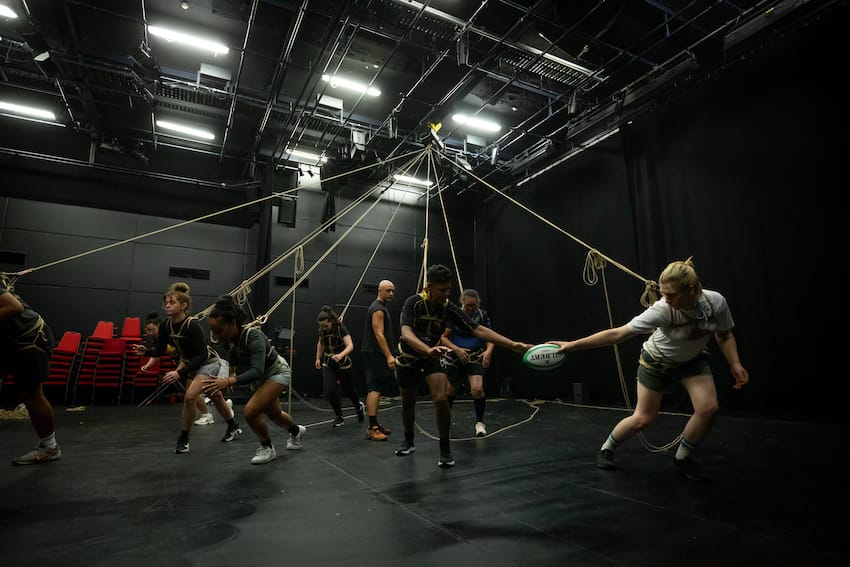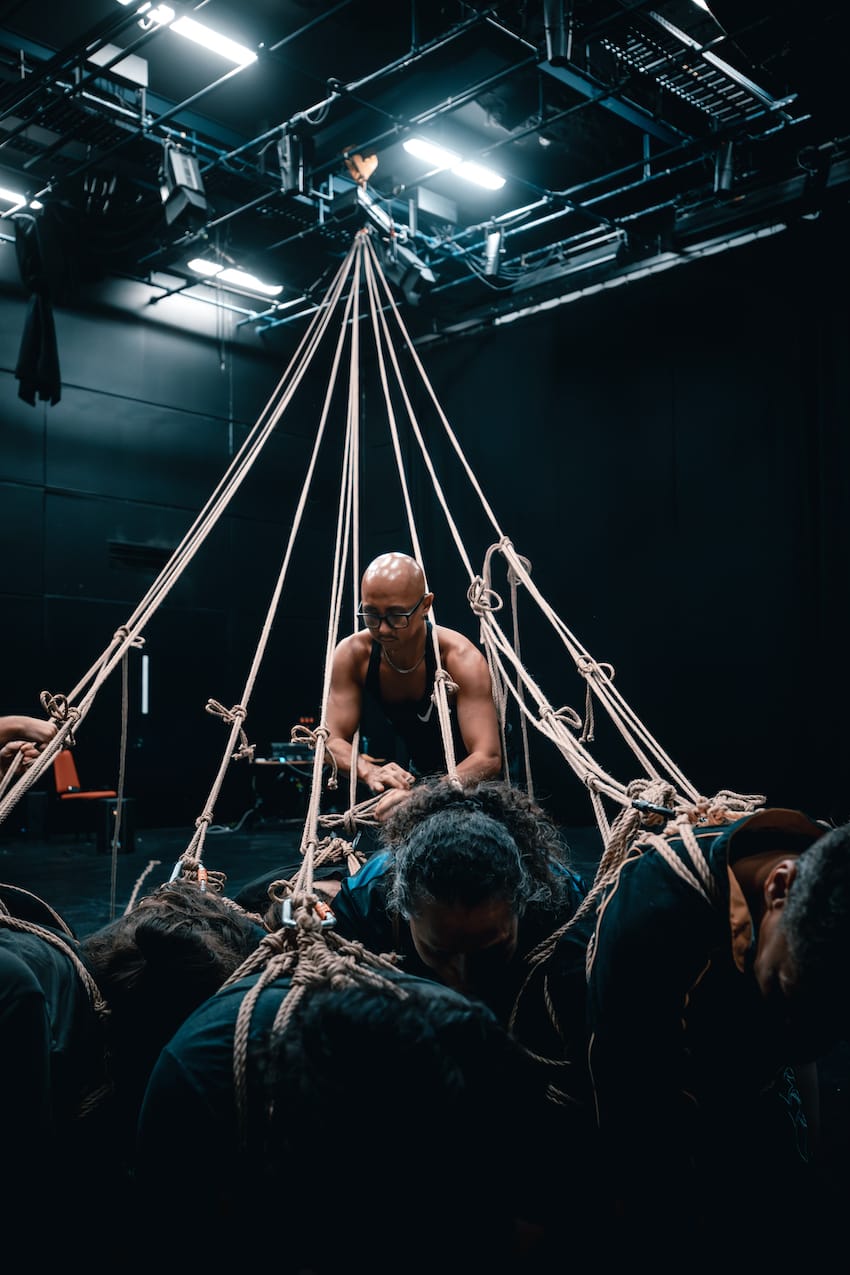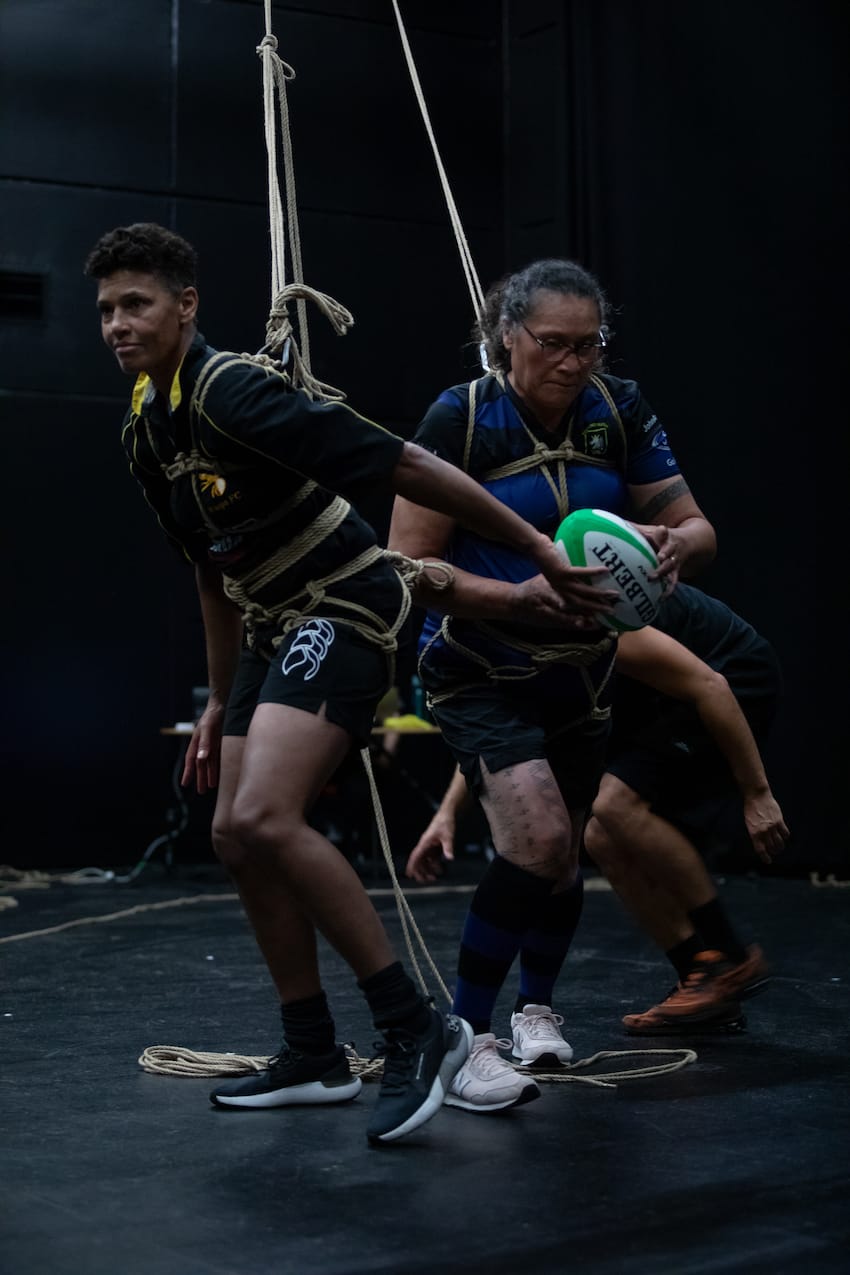The rope that binds: Still Lives brings rugby and art together

Art and sport are often pitted against each other. This weekend, Still Lives brings the two together for a performance installation.
This weekend, Auckland Town Hall’s Concert Chamber will play host to a performance unlike any it will have ever seen. Over the course of three hours, Eight female-identifying players will use ropes to tie their bodies together, recreating one half of a scrum. The work, Still Lives is a site-specific performance art installation, in which artists Luke George (Naarm/Melbourne) and Daniel Kok (Singapore/Berlin) use their rope practice to capture a moment in time. It comes to Auckland after acclaimed runs in Shanghai, Venice, and Melbourne as part of this year’s Festival of Live Art.
The focus of this specific iteration is the world of women’s rugby, and specifically the tension experienced by the players in the game they love. From the first piece of rope being tied onto a player to the last piece being taken off, the audience will watch them create a living sculpture that references the game itself. The work is also a means to connect disparate communities – arts, sports, queer, and even kink – in the same space.
When George and Kok first met as dancers, rope was an interest that drew them together. “Ropes were initially a way to think about how we literally connect with each other,” Kok says. “It was useful for that, but it very quickly evolved to make us think about the issues and dynamics that come up when one person ties another person.” On top of that was the complexity that is added when an audience is added to the equation; suddenly dynamics like who is looking at what, or who wants want from whom become relevant.
“When you talk about rope practice, you’re talking about the practice of bonding, breathing, and listening – the acquiescence of individuals towards each other, and then the material itself,” George says. The rope becomes a metaphor for the practice; soft, malleable, put to many uses. “It can respond to objects and bodies, move through space, connect things across space.”
“We’re not bringing a sculpture to a place or building something. It’s very ephemeral in its nature.”

From that initial point, George and Kok extended their practice to explore what it meant to tie a group of people together – literally, but also as a metaphor for social relationships. The duo have been working together for ten years and have learned a lot about the form. “We know what is happening in a performance situation, what things come forward in the space, and we’ve also learned a lot about how to allow those things to be present,” George says. “But every time we go somewhere new there’s a whole new set of materials, people, dynamics and stories.”
“The really fun part is finding how to bring them together into a single image.”
Still Lives started as a series of work about “tying up” a place, but has since evolved. “How do you tie up Melbourne? How do you tie up Tamaki?,” Kok says. “Each city is different. The conversations and the relationships people have with each other around race, gender, sexuality are very specific to those places.”
Despite having worked with sports players in the past – including football players in Melbourne – the Still Lives series isn’t explicitly about sport. “We didn’t set out to make an art meets sport kind of project. Many artists have tried,” George jokes. “For us it was more about the potential relationships and points of difference coming into the same space with each other, and the different communities of audience that make up the rest of the room.” (It doesn’t hurt that the athletes they work with have the required physicality and endurance to actually perform the work.)
Each performance of Still Lives is the result of many conversations and considerations. The duo visited Auckland towards the end of last year, and a conversation with FOLA started six months before that. They were keenly aware of their role as foreigners to the country, and that complex cultural conversations – in both arts and sport – have been going on here as long as both have existed. This meant that extra consideration had to be taken: what would it mean for them to step into that and be invited to be part of Aotearoa’s cultural conversation as a visitor?”
In a festival context, artists are generally treated as guests rather than visitors; they bring their work, unchanged and unaltered. Being a guest is a position of privilege, while a visitor must take considerations. “We can’t just dump some art here and leave,” says Kok.
“Nor can we just swoop in and glean something about a place, make a social comment with our own lens,” adds George.

It’s fitting that the practice of building the work with their chosen community is compatible with rope practice. Building each iteration of Still Lives isn’t just about tying somebody up aesthetically and safety, but about being responsive to each individual situation. “So much is embedded in rope practice itself,” says Kok. “We extend that to this idea of taking our work and practices to a new place. How do we flow with it? How do we tai chi with it?”
From there, the recruitment of players had to happen. Legendary sports photographer Jo Caird was one of the lead consultants on the show and was instrumental in connecting the duo to players due to her relationships with players. That buy-in is especially crucial when it comes to a participation-averse country like New Zealand, and especially for them as queer artists reaching into a sporting space.
The actual process of rehearsing the show – of not just building the specific image they will create in the performance, but building the relationships amongst the team – varies depending on the iteration. This iteration involves a two week rehearsal process, working with stand-ins to build the design, and slowly adding the players to the process throughout.
“It’s important for us to develop friendships and relationships with them, and build open lines of communication,” George says. “It’s finding out really simple things like what their body needs to be able to do to perform something like that.”
It might sound slightly obvious due to the literal material used in the show, but connection is a huge part of Still Lives. It also makes sense that rugby players are the focal point of this show; it is a sport that reaches into all kinds of sociopolitical conversations, and in a way that actually runs parallel to the conversations happening in arts and culture: celebrating diversity, enabling access, and highlighting other people’s identities.
Both are very clear that despite the words community and connection coming up a lot, this is not necessarily a piece of community art or a cultural development experience. “Those practices have long, deep, histories,” says George. “They’re about longevity, consistency, building, and remaining in place. That’s not what we’re here to do. These experiences are temporary or ephemeral public art.”
For Kok, the more relevant word is engagement – how to keep engaging with audiences post-pandemic? The idea of a general public that goes to a show to sit in the dark doesn’t really exist anymore and that model doesn’t speak to the way they want to work anymore. “How can we really bring different people together, to think together, to see each other?”, Kok asks.
“These are experiments in finding other ways to make people come together, for us to choreograph those situations, and to foster different, deeper, more rigorous ways to engage people.”
For three hours, eight people will be engaged in a very different way than ever before. Beyond those eight, an audience will be similarly engaged – and yes, connected – in a way that is no less profound, and will likely last long after the last piece of rope falls away.
Still Lives: Auckland will be performed at the Concert Chamber in Auckland Town Hall from 5.30pm on Saturday March 30. It is free to attend.
Writing and reporting takes time, and if you want to support the amount of time it takes (and ensure that the scant amount of meaningful coverage of local art can continue), please considering supporting Dramatic Pause with a paid subscription ($8 p/m, $60 p/a) and if you can't afford a paid subscription, please share the work with your networks!
Member discussion